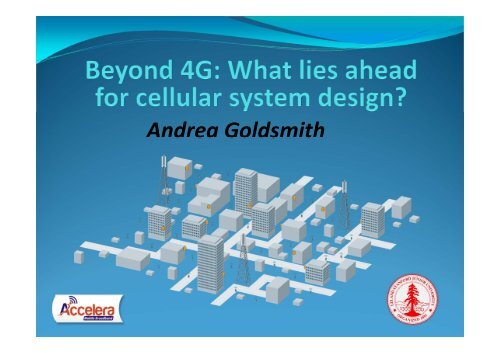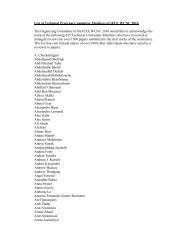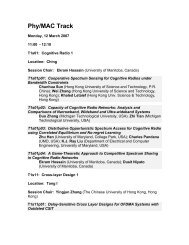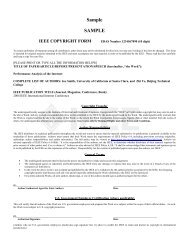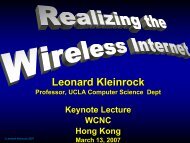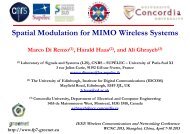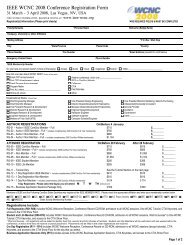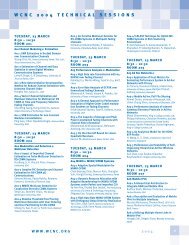WCNC 2012 keynote presentation to download
WCNC 2012 keynote presentation to download
WCNC 2012 keynote presentation to download
- No tags were found...
You also want an ePaper? Increase the reach of your titles
YUMPU automatically turns print PDFs into web optimized ePapers that Google loves.
Are we at the Shannonlimit of the Physical Layer?We don’t know the Shannoncapacity of most wireless channels• Time‐varying channels with memory/feedback.• Channels with interference or relays.• Uplink and downlink channels withfrequency reuse, i.e. cellular systems.• Channels with delay/energy/$$$ constraints.
Rethinking “Cells” in CellularCoopMIMORelayDASSmallCellHow should cellularsystems be designed?Will gains in practice bebig or incremental; incapacity or coverage?• Traditional cellular design “interference‐limited”• MIMO/multiuser detection can remove interference• Cooperating BSs form a MIMO array: what is a cell?• Relays change cell shape and boundaries• Distributed antennas move BS <strong>to</strong>wards cell boundary• Small cells create a cell within a cell• Mobile cooperation via relaying, virtual MIMO, analog network coding.
Are small cells the solution <strong>to</strong>increase cellular system capacity?Yes, with reuse one and adaptivetechniques (Alouini/Goldsmith 1999)Area Spectral EfficiencyA=D 2 • S/I increases with reuse distance (increases link capacity).• Tradeoff between reuse distance and link spectral efficiency (bps/Hz).• Area Spectral Efficiency: A e =R i /(D 2 ) bps/Hz/Km 2 .
The Future Cellular Network: HierarchicalArchitectureToday’s architectureMACRO: solvinginitial coverageissue, existingnetwork• 3M Macrocells serving 5 billion users• Anticipated10x Lower COST/MbpsPICO:solvingstreet, enterprise& homecoverage/capacityissue(morewith WiFiOffload)FEMTO: solvingenterprise &homecoverage/capacityissueMacrocell PicocellFem<strong>to</strong>cell10x CAPACITYImprovementNear 100%COVERAGEFuture systems require Self‐Organization (SON) and WiFi Offload
Traditional Macro vs. SON Enabled H-RANMacro BS OnlyChicago Down<strong>to</strong>wnModeling Assumptions:1. Chicago Down<strong>to</strong>wn model(Calculation area: 64.5km 2 )2. 38 Macro BS sites (3sec<strong>to</strong>rs)3. 340 Pico BS (3 sec<strong>to</strong>rs)4. ~66000 users weresimulated with MonteCarlo methodH-RAN: Macro + Pico BSH-RAN advantage‣ 10x CAPACITY‣ 10x lower $/Mbps‣ ~100%COVERAGEMacro BS Macro + Pico optimizedUsers trying <strong>to</strong> connect 66680 66680Connected users 31023 50902Effective MAC AggregateThroughput (DL) 1020 Mbps 12 060 MbpsEffective MAC AggregateThroughput (UL) 389 Mbps 4 204 MbpsMacro BS ‐ Cost Per MbpsPico BS ‐ Cost Per Mbps(no backhaul/site acq)CapEx Reduction Fac<strong>to</strong>r$1,341/Mbps$111/Mbps12x
Why SoN? Deployment ChallengesDeploying One MacrocellEffort(MD –ManDay)New site verification 1On site visit: site details verification 0.5On site visit: RF survey 0.5New site RF plan 2Neighbors, frequency,0.5preamble/scrambling code planInterference analyses on surrounding0.5sitesCapacity analyses 0.5Handover analyses 0.5Implementation on new node(s) 0.5Field measurements and verification 2Optimization 2Total activities7.5 man days5M Pico base stations in 2015 1 :• 37.5M Man Days = 103k Man Years•Exorbitant costs•Where <strong>to</strong> find so many engineers?Why SoN?• Au<strong>to</strong>mated configuration• Interference Management• Throughput/CoverageOptimization• Mobility Management• Cellular Offload1Source: ABI Research
Self-Healing Capabilities of SONMacrocell BS FailurePicocell/Fem<strong>to</strong>cell BS Failure• SON algorithm detects failures in macro/pico/fem<strong>to</strong> BSs• Dynamically adjusts TX power and antenna tilt of <strong>to</strong>cover “orphaned” mobiles• Similar algorithm used <strong>to</strong> shut down BSs <strong>to</strong> save energy
SON Premise and ArchitectureNodeInstallationSelfHealingMobile GatewayOr CloudSoNServerInitialMeasurementsSelfConfigurationMeasurementSONServerSelfOptimizationIP NetworkX2X2X2X2Small cell BSMacrocell BS
Algorithmic Challenge: Complexity• Optimal channel allocation was NP hard in2 nd -generation (voice) IS-54 systems• Now we have MIMO, multiple frequencybands, hierarchical networks, …• But convex optimization has advanced a lotin the last 20 yearsInnovation needed <strong>to</strong> tame the complexity
Cognitive RadiosI PCRTxCRRxCellularCellularCRMIMO Cognitive UnderlayCRCellularTxCognitive OverlayCellular Rx• Cognitive radios support new wireless users in existingcrowded spectrum without degrading licensed users• Utilize advanced communication and DSP techniques• Coupled with novel spectrum allocation policies• Technology could• Revolutionize the way spectrum is allocated worldwide• Provide more bandwidth for new applications/services• Multiple paradigms• Underlay (exploiting unused spatial dimensions) and Overlay(exploiting relaying and interference cancellation) promising
Cellular Systems with Cognitive RelaysCognitive Relay 1dataSourceCognitive Relay 2• Enhance robustness and capacity via cognitive relays• Cognitive relays overhear the source messages• Cognitive relays then cooperate with the transmitter in thetransmission of the source messages• Can relay the message even if transmitter fails due <strong>to</strong> congestion, etc.
Green” Cellular NetworksCoopMIMORelayPico/Fem<strong>to</strong>How should cellularsystems be redesignedfor minimum energy?DASResearch indicates thatsignificant savings is possible• Minimize energy at both the mobile and base station via• New Infrastuctures: cell size, BS placement, DAS, Picos, relays• New Pro<strong>to</strong>cols: Cell Zooming, Coop MIMO, RRM, Scheduling,Sleeping, Relaying• Low‐Power (Green) Radios: Radio Architectures, Modulation,coding, MIMO
Antenna Placement in DAS• Optimize distributed BS antenna location• Primal/dual optimization framework• Convex; standard solutions apply• For 4+ ports, one moves <strong>to</strong> the center• Up <strong>to</strong> 23 dB power gain in downlink• Gain higher when CSIT not available6 Ports3 Ports
Device Challenges•Size and Cost••Multiband Antennas•Multiradio Coexistance•IntegrationBTCellularAppsProcessorMediaProcessorFM/XMGPSDVB-HWLANWimax
Software‐Defined (SD) Radio:Is this the solution <strong>to</strong> the device challenges?BTFM/XMA/DCellularAppsProcessorGPSDVB-HWLANA/DA/DDSPMediaProcessorWimaxA/D• Wideband antennas and A/Ds span BW of desired signals• DSP programmed <strong>to</strong> process desired signal: no specialized HWToday, this is not cost, size, or power efficientCompressed sensing may be a solution for sparse signals
Compressed Sensing• Basic premise is that signals with some sparse structurecan be sampled below their Nyquist rate• Signal can be perfectly reconstructed from thesesamples by exploiting signal sparsity• This significantly reduces the burden on the front‐endA/D converter, as well as the DSP and s<strong>to</strong>rage• Key enabler for SD, low‐energy, and white‐space radios?• Only for incoming signals “sparse” in time, freq., space, etc.
Codes for minimal <strong>to</strong>tal energy consumptionIs Shannon‐capacity still a good metric for system design?
Power consumption via a network graphpower consumed in nodes and wiresB 1B 2B 3X 5X 6B 4X 7X 8Extends early work of El Gamal et. al.’84 and Thompson’80
• Stay away from capacity!• Close <strong>to</strong> capacity we need• Large chip‐area• More decoding time• More powerCode Optimization
Summary• Much work <strong>to</strong> be done on future cellular system design• We are not at the Shannon limit of the PHY, and don’teven know what it is.• The “optimal” way <strong>to</strong> design cellular networks is wideopen for innovation.• True breakthroughs in hardware needed• The challenges <strong>to</strong> make future cellular systemssuccessful are not only technical.


